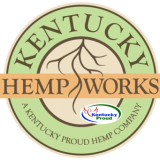Today at work I ran out to one of the hemp fields to take pictures of the plants. Our friends at Commonwealth Extracts wanted to see how the ladies were doing so I got nominated to visite the girls and give them some proper headshots.
Of course, they looked amazing and I wanted to share just how beautiful they are, but at the same time, I wanted to use this as a chance to plant some free seeds of knowledge for those who are new to the cannabis plant.
This plant has a multitude of uses and each part of the plant holds it’s own promise as a tool for the development of mankind. that’s why we use the entire plant at Kentucky Hemp Works, from root to top. The seeds, the stalks, the leaves and nudes all have their purpose and we are only just beginning to scratch the surface of everything it can do.
In this photo, we are looking at the very top of the plant (the bud or “flower”) which houses thousands of tiny hairs all over. Those hairs, called trichomes, are sticky little mushroom-shaped extensions of the plant that carry the wholes spectrum of cannabinoids, terpenes, and flavonoids found in cannabis. If you look closely at the picture you can see these hairs; They look like a light dusting of frost. In a high CBD or THC producing corp, that dusting of frost is the end product, separated from the plant using CO2 extraction preferably. That’s what goes into our CBD Drops, and is quite frankly, what all the fuss is about.
On the other hand:
In a SEED crop those sticky, resinous little hairs serve an entirely different purpose. Their job is to catch pollen from male plants as it floats through the air. Hemp is a self-pollinating plant. It does not depend on birds, bugs or other critters to sow their wild oats. these lucky guys just let their balls hang out in the wind (litterallyO and pollinate thousands of female plants with little to no effort. THen they die off, early and happy, while the ladies are left to do all the work.
Those girls then start producing their powerful seeds, dawing from the rain and sun all the energy we need for food — and fuel — and depositing in it tiny little nuts/seeds called achene. We then collect, clean and crush those seeds to squeeze out the vegetable oil within. That vegetable oil is packed with nutrients, omega fatty acids and everything we need for good brain cardiovascular function. They are literally seeds of life.
Although this is just one part of the plant, it’s got a number of uses. Resinous extracts and seed are just two of them. They could be brewed in tea for relaxation, used in a salad for a zesty, butter flavor that is not overpowering like arugula or even used as biomass for energy (although we wouldn’t want to see all that wholesome nutrition go to waste.)
Then there’s the stalks, fibers, and even the roots of the plant, which all have their own uses as well.
Buts that’s a lesson for another day…peace out, cub scout.
– Katie


